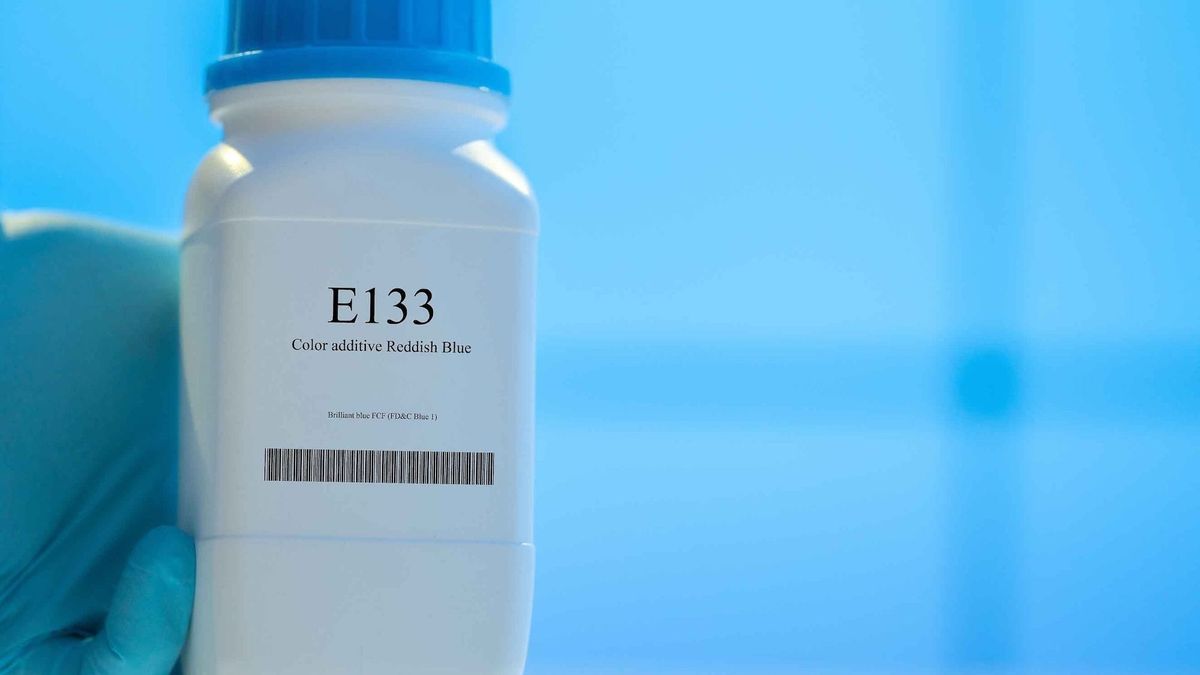
E133 is a bright blue synthetic food coloring. In what foods is it found? What is its authorized daily dose? Is it harmful in high doses? The answers from Anthony Fardet, researcher in preventive and sustainable food.
What is the food additive e133, brilliant blue coloring?
Also known as Brilliant Blue FCF or Patent Blue V, the food additive code E133 is a bright blue synthetic dye. It comes in liquid or powder form, dark blue to purple. E133 is not a natural coloring, since it comes from several chemical reactions between organic compounds. It is also its synthetic nature which means that this dye can be produced in a controlled and standardized manner, which makes it possible to obtain a stable and uniform blue color for use in various food products.
What is the ADI for e133 or brilliant blue FCF?
The ADI (acceptable daily intake) of a food additive corresponds to an estimate of the quantity of this additive that a person can consume daily over the course of their life without appreciable risk to health.
That of brilliant blue FCF has been set at 6 mg per kg of body weight per day by the scientific group of the European Food Safety Authority (EFSA). This limit of use is based on safety evaluations of available toxicological data.
Danger: Is brilliant blue harmful and what are the risks of consuming it?
According to EFSA estimates, even at the maximum consumption levels studied, intake estimates are lower than this ADI of 6 mg/kg bw/d, and this synthetic blue dye is neither carcinogenic, neither genotoxic nor reprotoxic.
On the other hand, several scientific studies have observed a link between the consumption of synthetic food colorings (of which E133 is one) and symptoms of ADHD and hyperactivity in children. “However, we have observed that a 6-year-old child could easily absorb up to 40 additives per day, between biscuits and industrial snacks, sodas, breakfast cereals and prepared meals. It's huge, the stakes are very high” adds the expert.
E133 is also part of the so-called cosmetic additives which include all texturing agents, emulsifiers, colorings and flavorings and which artificially modify the color, texture and taste properties of foods. “These cosmetic additives are not essential and their presence in a food testifies to its degree of processing. The more numerous they are, the more the food is transformed.” explains Anthony Fardet, who nevertheless recommends limiting foods containing several additives as much as possible. “Moreover, it is not because an additive alone poses a problem. no or little health problem that its consumption is safe. Combined with other additives, it can become problematic: this is what we call the cocktail effect.” adds the expert.
Finally, E133 is suspected of being allergenic, particularly in asthmatics and people intolerant to salicylates. It could even cause, in very rare cases, hives or respiratory symptoms.
Ingredient E133: is it halal or haram? and is it vegan?
Generally, synthetic food additives like E133 are not derived from animal sources and are not subject to controversial processes, making them generally considered halal under Islamic law. Not being made from animal products, it is also compatible with the vegan diet. However, E133 is prohibited in food from organic farming.
How are food additives classified?
Food additives are classified into 9 categories depending on their role:
- Food colorings, which can be of natural or synthetic origin;
- Preservatives to extend their shelf life;
- Antioxidants to prevent the oxidation of fats in foods;
- Sweeteners to give a sweet flavor to foods without adding sugar;
- Emulsifiers to stabilize mixtures of ingredients;
- Texturing agents (thickeners, gelling agents, stabilizers and bulking agents);
- Flavorings and flavor enhancers;
- Acidifiers to regulate acidity;
- Leavening agents added to baked goods to help dough rise.
NO to diets, YES to WW!
Candy, drinks: in what foods is E133 found?
Brilliant Blue FCF is a cheap and easy-to-manufacture additive, which is why it is widely used in the food and beverage industry to give foods and beverages an attractive bright blue color. It is found in particular in many non-alcoholic drinks (sodas, fruit drinks, energy drinks), in confectionery (candies, chewing gum, lollipops, etc.), in biscuits (cakes, pastries and cupcakes) and in desserts (ice creams, yogurts, sorbets).
Overall, it is found in all blue or purple colored foods. E133 is also widely used in the pharmaceutical and cosmetics industries, in many products such as soaps, shower gels, shampoo, shaving foam and mouthwash.
What additives are prohibited?
Food additives that are not explicitly authorized in Europe are considered prohibited. The list is therefore non-exhaustive since currently, 320 additives are authorized in Europe, while – for example – some 450 are authorized in Canada. The list of additives authorized in Europe is available on the website of the Ministry of Agriculture and Food Sovereignty.

